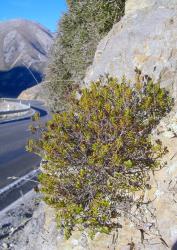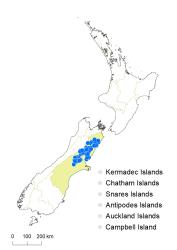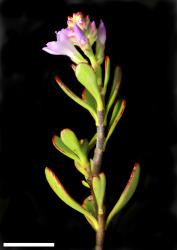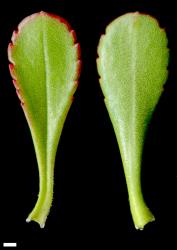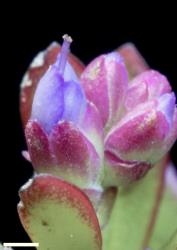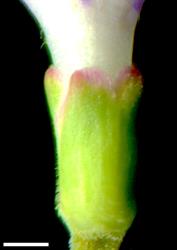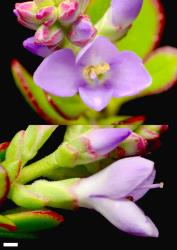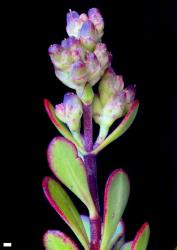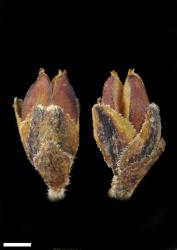- ≡ Hebe raoulii (Hook.f.) Cockayne & Allan, Trans. New Zealand Inst. 57: 44 (1926)
- ≡ Heliohebe raoulii (Hook.f.) Garn.-Jones, New Zealand J. Bot. 31: 333 (1993)
- ≡ Parahebe raoulii (Hook.f.) Heads, Bot. J. Linn. Soc. 115: 81 (1994)
Sub-shrub or low shrub to 0.3 m tall. Stems ascending to erect, eglandular-pubescent; hairs uniform, short, reflexed, appressed; minute glandular hairs sometimes also present. Leaf bud indistinct, leaves separating while very small, opposite-decussate, erecto-patent to spreading or recurved, separating early; lamina coriaceous, usually oblanceolate to obovate or spathulate, sometimes linear-oblanceolate, 7–25 mm long, 2–9 mm wide, glossy green bronze-green or yellowish-green above, dull pale green to yellowish-green beneath; midrib evident; surfaces glabrous; margin glabrous or eglandular- and glandular-ciliate towards base, serrate or bluntly serrate, teeth in 2–6, rarely 0–1, sometimes up to 8, pairs; apex acute or sub-acute and usually sub-apiculate; base cuneate; petiole 2–5 mm long. Inflorescence a terminal compound spike or raceme, 20–55 mm long; flowers crowded, 16–100 per inflorescence, all bisexual; bracts opposite, becoming alternate, deltoid, > pedicels; pedicels erecto-patent, 0–0.5 mm long, eglandular-hairy all around. Calyx lobes 4, the anterior pair usually fused at least ⅔-way to apex, rarely less or almost free, obtuse, 2–4 mm long, unequal, eglandular-ciliate, or mixed eglandular- and glandular-ciliate. Corolla 6–8 mm diameter; tube pink, purplish or white, 2.0–3.5 mm long, about = calyx, glabrous; lobes 4, pink, purplish, or white, erect to spreading, sub-equal, lanceolate, elliptic, oblong or rhomboid, 2.5–3.5 mm long, sub-acute to obtuse; nectar guides absent. Stamen filaments white, 1.5–2.0 mm long; anthers yellow. Style glabrous, 4–6 mm long. Capsules turgid or weakly latiseptate, truncate, glabrous, 3–4 mm long, 1.8–3.0 mm at widest point. Seeds fusiform or irregular, flattened or weakly flattened, winged, smooth, straw-yellow to pale brown, 1.2–2.2 mm long.
Among the species of the sun hebe group, plants of V. hulkeana and V. lavaudiana can be distinguished from V. raoulii plants by their larger leaves.
V. maccaskillii plants are similar in usually having the anterior calyx lobes fused, but are distinguished by their almost divaricating and compact habit, shorter, more rounded leaves with fewer teeth, and usually a small fifth 5-calyx lobe.
V. scrupea plants are similar in having four calyx lobes, but their leaves are narrower, more toothed, and more acute, flowers are smaller with shorter stamens, and the anterior calyx lobes are free.
V. pentasepala plants may be similar in size and overall appearance, but are usually taller and more stiffly erect, and distinguished by having five calyx lobes that are all separate.
South Island: Marlborough (Seaward Kaikōura Range, Tarndale); Canterbury (Seaward Kaikōura Range, Mt Terako, Hanmer Springs region, Hurunui and Waiau Valleys, and along the foothills of the southern alps to Rakaia Gorge). I have accepted and mapped Norton and Molloy’s (2009) record from Mt Cass; those plants have broader leaves, and often the anterior calyx lobes there are free.
Two collections said to be from Banks Peninsula are regarded as doubtful and not accepted here.
Rock outcrops in scrub and grassland, occasionally on talus or scree. Recorded elevations range from 350 to 1282 m.
Although the distribution of V. raoulii overlaps those of V. scrupea, V. hulkeana, V. maccaskillii, and V. pentasepala, wild hybrids have not been noted. Veronica ‘Hagley Park’ is the hybrid V. hulkeana × raoulii, which arose in cultivation (Metcalf 2001).
Flowers: September–December; fruits: December–February.
2n = 42 (Hair 1967, as Hebe raoulii var. raoulii).
Veronica raoulii is classified in V. subg. Pseudoveronica sect. Hebe and informally in the “sun hebe” group (Albach & Meudt 2010). Chloroplast DNA sequence data place V. raoulii close to V. hulkeana and V. lavaudiana; ITS sequence data indicate a relationship with V. pentasepala (Albach & Meudt 2010). A morphology-based cladogram (Garnock-Jones 1993) suggests a close relationship with V. maccaskillii.
Cultivars
Veronica ‘Hagley Park’ is the cultivated hybrid between V. hulkeana and V. raoulii.



